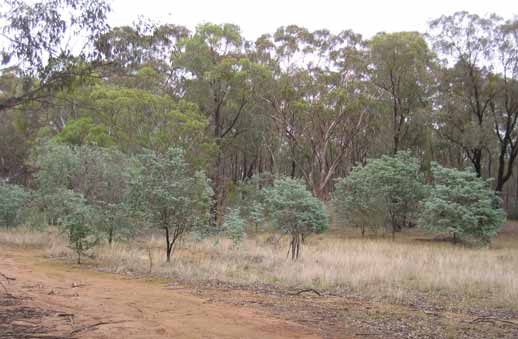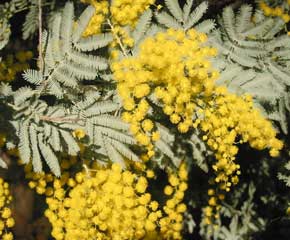Acacia baileyana (Cootamundra Wattle) is the floral emblem of the small rural township of Cootamundra which is located on the western slopes of New South Wales, about 350 km southwest of Sydney. Cootamundra Wattle is now the logo of many local businesses, organizations and the Shire Council in Cootamundra.
Cootamundra Wattle is a well-known Australian species, principally on account of its popularity in cultivation (both within Australia and abroad). In 1986 it’s profile was enhanced following the release of John Williamson’s song Cootamundra Wattle. The species is featured on an Australian stamp and appears in many popular and scientific publications, for example, Archibald Campbell’s book Golden Wattle which was published in 1921.
Acacia baileyana was originally described by Baron von Mueller in 1888, based on a plant cultivated in 1876 at Bowen Park, Brisbane, by the Queensland botanist, Frederick Manson Bailey (after whom the species was named).
Acacia baileyana has a very restricted natural distribution which is confined to the vicinity of Cootamundra, hence its common name. In its native habitat the species is found in sheltered situations, generally on elevated sites, between Stockinbingal, Temora, Cootamundra and Bethungra (a distance of only about 50 km, east to west). According to information provided at the Cootamundra Shire’s website the natural range of the species was determined in 1935 as a result of a seven-month study conducted by the National Herbarium of New South Wales. This site also provides locations around the district where the species may be viewed in its natural habitat, including the Jindalee State Forest, a location where both the normal form and a form with purple tipped foliage (see below) grow together. Cootamundra Shire Council has planted Cootamundra Wattle at strategic locations within the town and on town approaches. A tourist brochure is available from the Cootamundra Tourist Information Centre showing these locations.

Cootamundra Wattle population in Jindalee State Forest
Characteristics of Cootamundra Wattle
Cootamundra Wattle grows to a large bushy shrub or small tree, commonly reaching 5–10 m high, and is typically freely branching from 1–2 m above the ground, plants growing in dense regrowth stands tend to be somewhat spindly whereas in open sites they are more robust. The short bipinnate leaves are usually blue-grey in colour, the flower heads are lemon yellow and arranged elongated, showy racemes, and the relatively large pods are flat and covered with a white bloom when young.
The species flowers mostly between June and early September with individual trees flowering for only a few weeks (Boden 1969); Whibley & Symon (1992) report observations by L. Pryor of both early and late flowering variants.
Cootamundra Wattle is an adaptable, fairly hardy species that is fast-growing, relatively short-lived, frost resistant and which prefers cool, higher rainfall areas. It is very popular in cultivation and in some areas it has escaped from gardens and is considered an environmental weed (see below). The species was recently assessed as having some potential for cultivation in parts of the southern Australian agricultural region as a crop for woody biomass production (see Maslin & McDonald, in press).

Flowers of Acacia baileyana (Cootamundra Wattle)
Horticulture
Acacia baileyana has been extensively planted as an ornamental, for its foliage and floral display, both within Australia (especially in areas south of the Tropic of Capricorn) and abroad. Cultivars with purple or yellow leaves, reddish new growth or prostrate growth form, are now available (Whibley & Symon 1992); these forms can be grown from cuttings (Simmons 1988). The registed cultivar A. baileyana 'Purpurea' with its purple coloured leaves is very attractive. Overseas Cootamundra Wattle is grown in temperate climates of New Zealand, South America, South Africa and southern Europe (Hall & Turnbull 1979). Experiments by Morgan & Sedgley (2002) suggest that temperature could be used to manipulate flowering for the commercial production of cut stems or pot plants at specific times of the year.
Weed potential
In some areas, both within Australia and abroad, A. baileyana has spread from garden plantings into surrounding areas and is regarded as an environmental weed, especially in higher rainfall regions. Invasive populations occur in parts of Western Australia, South Australia, Queensland, New South Wales and Victoria (Hall & Turnbull 1979; Tindale & Kodela 2001 provide maps of both the native and naturalized distributions). This species has also become naturalized in New Zealand (Webb et al. 1988) while in South Africa it is classed as a category 3 Declared Invader (see Henderson 2001, who also provides a map of its distribution).
Morgan et al. (2002) showed that important factors that contribute to the weediness of A. baileyana are its ability to produce high numbers of flowers (which may occur in plants as young as 2 years old) which result in high seed production. Under appropriate conditions the seedlings establish in large numbers; fires and mechanical disturbance (which may occur along road verges and power lines, etc.) can increase the spread by stimulating mass germination. The dispersal of plants and seed by humans is an important factor in the weed success of this species.
Further information
Detailed botanical descriptions and illustrations/photographs of this species are provided by Maiden (1908), Cunningham et al. (1981), Costermans (1981), Simmons (1988), Tame (1992), Whibley & Symon (1992), Tindale & Kodela (2001 & 2001a) and Kodela (2002).
A description is also provided by the National Herbarium of New South Wales on the WattleWeb.
A distribution map, generated in real-time and based on specimen point-source data held by major Australian herbaria, are also available through Australia’s Virtual Herbarium. These map can be requested by accessing an appropriate AVH node via the Council of Heads of Australian Herbaria website.
Other information can also be found at the Cootamundra Shire website.
References
Boden, R.W. (1969). Variation and inheritance of flowering in Acacia baileyana. Australian Plants 5: 230–237.
Campbell, A.J. (1921). Golden Wattle. Our national floral emblem. (Osbboldstone & Co: Melbourne.)
Costermans, L. (1981). Native Trees and Shrubs of South-eastern Australia. (Published by Rigby Publishers Ltd)
Cunningham, G. H., Mulham, W.E., Milthorpe, P.L. and Leigh, J.H. (1981). Plants of western New South Wales. (Government Printer, Sydney.)
Hall, N. and Turnbull, J.W. (1979). Acacia baileyana F. Muell. Australian Acacias Leaflet No. 6 (CSIRO Forest Research: Australian.)
Henderson, L. (2001). Alien weeds and invasive plants. A complete guide to declared weeds and invaders in South Africa. Plant Protection Research Institute Handbook No. 12. (Department of Agriculture and Department of Water Affairs and Forestry: South Africa.)
Kodela, P.G. (2002). Acacia. In Flora of New South Wales. Revised edition, Volume 2. (Ed. G.J. Harden), pp. 381–476. (University of New South Wales: Sydney.)
Maiden, J.H. (1908). Acacia baileyana. The Forest Flora of New South Wales. Volume 4, part 1. (Government Printer: Sydney.)
Maslin, B.R. and McDonald, M.W. (in press). AcaciaSearch: evaluation of Acacia as a woody crop option for southern Australia. Report to the Rural Industries Research and Development Corporation, Publication No. 03/017. (To be published by the Joint Venture Agroforestry Program.)
Morgan, A., Carthew, S.M. and Sedgley, M. (2002). Breeding system, reproductive efficiency and weed potential of Acacia baileyana. Australian Journal of Botany 50: 357–364.
Morgan, A. and Sedgley, M. (2002). Environmental control of bud formation and flowering of clonal Acacia baileyana F. Muell. for ornamental horticulture. Australian Journal of Experimental Agriculture 42: 211–216.
Simmons, M.H. (1988). Acacias Australia. Volume 2. (Viking O’Neil, Penguin Books Australia Ltd: Melbourne.)
Tame, T. (1992). Acacias of southeast Australia. (Kangaroo Press: Kenthurst, Sydney.)
Tindale, M.D. and Kodela, P.K. (2001). Flora of Australia. Volume 11A. (Australian Biological Resources Study, Canberra, & CSIRO Publishing, Melbourne.)
Tindale, M.D. and Kodela, P.K. (2001a). In WATTLE Acacias of Australia. (B.R. Maslin coordinator) CD ROM Publication. (Published by Australian Biological Resources Study, Canberra and Department of Conservation and Land Management, Perth.)
Webb, C.J., Sykes, W.R. and Garnock-Jones, P.J. (1988). Flora of New Zealand. Volume 4. (Botany Division, Department of Scientific and Industrial Research: Christchurch.)
Whibley, D.J.E. and Symon, D.E. (1992). Acacias of South Australia. (South Australian Government Printer: Adelaide.)